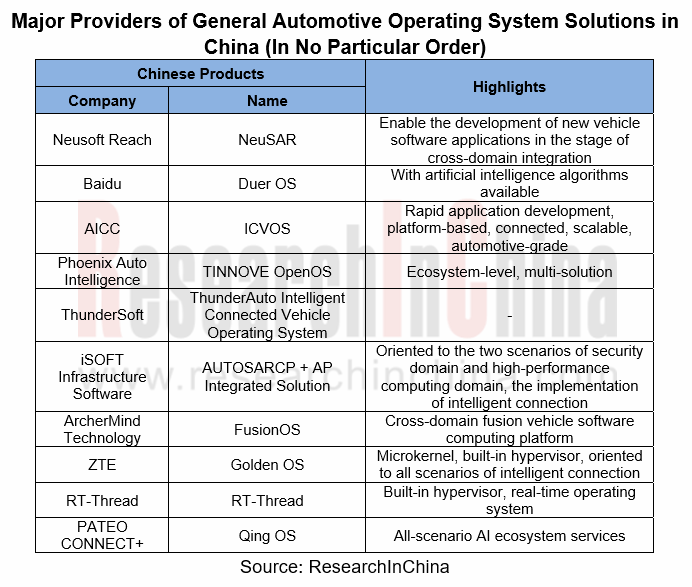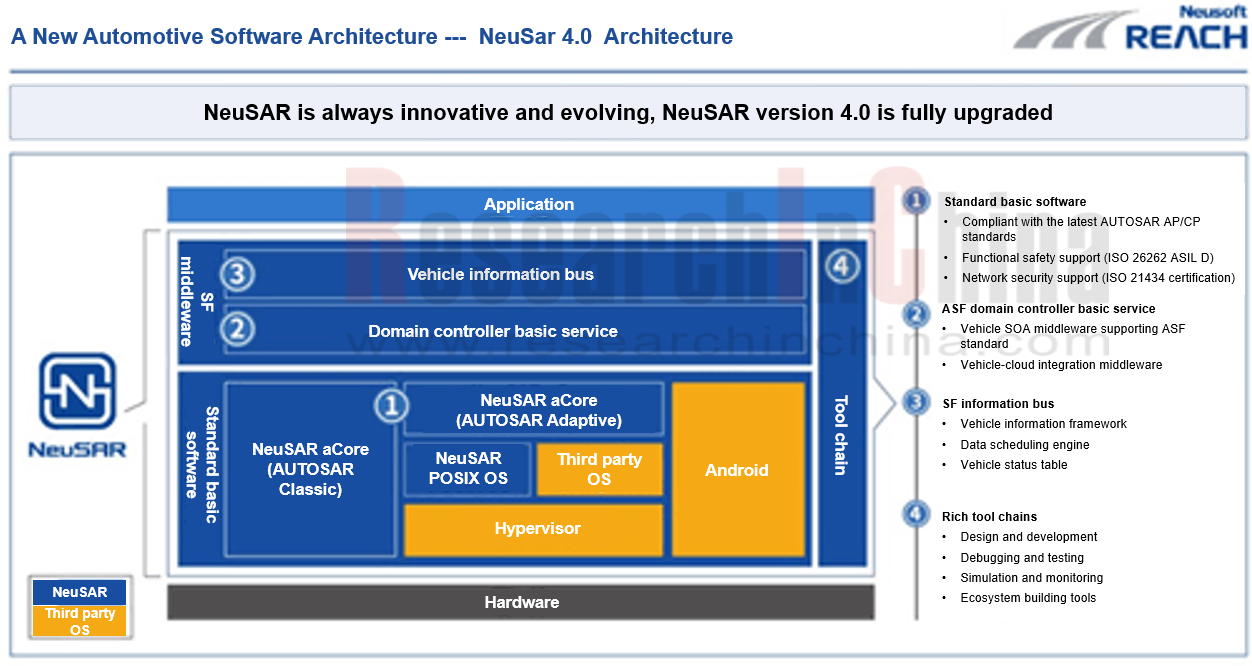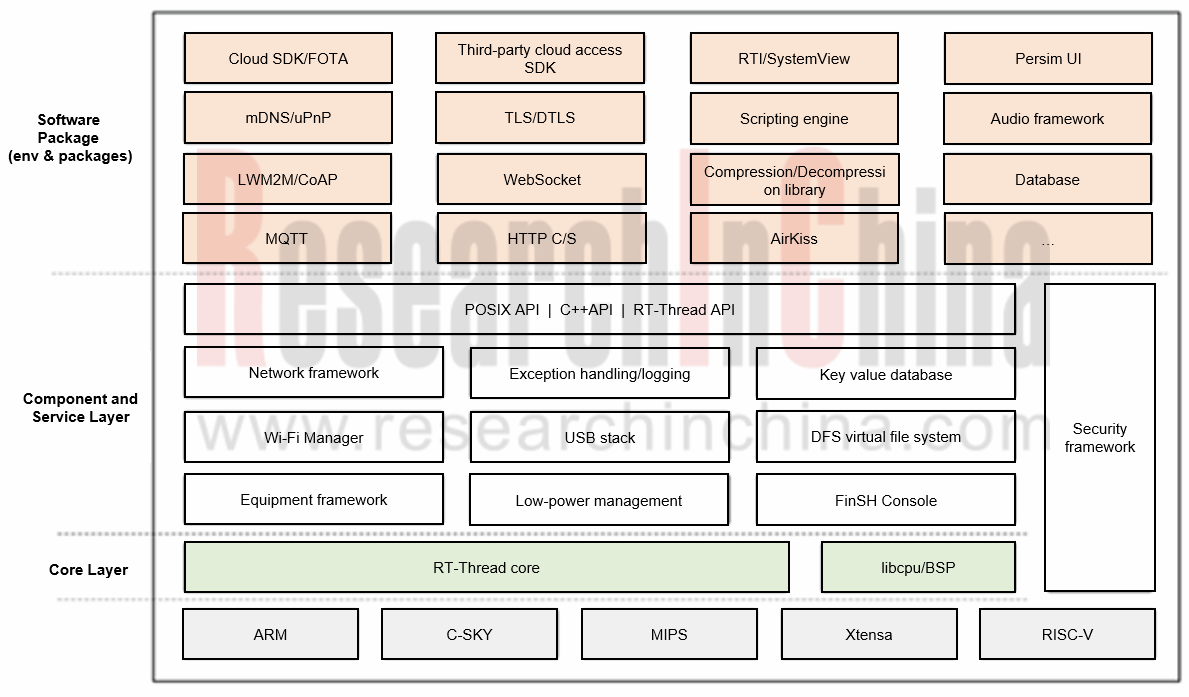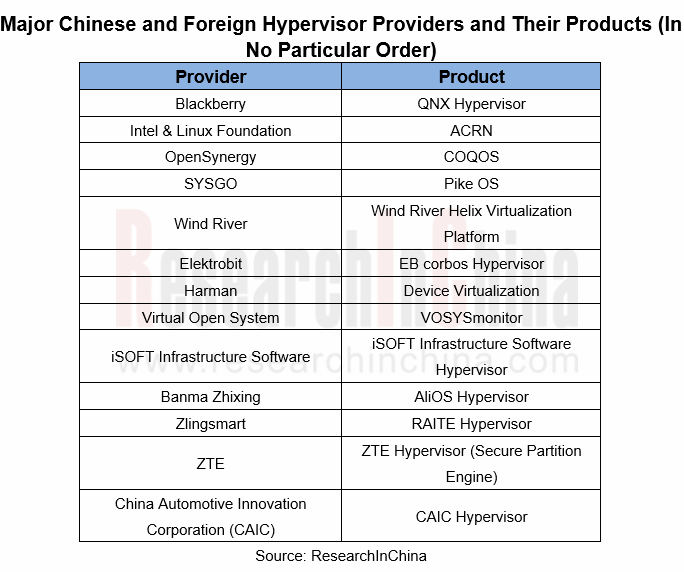Global and China Automotive Operating System (OS) Industry Report,2022
Operating system research: the automotive operating system for software and hardware cooperation enters the fast lane.
Basic operating system: foreign providers refine and burnish functions; Chinese providers expand software and hardware cooperation.
Internationally, Blackberry's QNX, Linux-based custom operating system, and Android open source project-based operating system are still the three major basic operating systems. In 2022, centering on the benefits of their own products, the three major providers, Blackberry, Intel & Linux Foundation, and Google, play to their strengths, and vigorously expand ecosystem cooperation with OEMs in more aspects: QNX works hard on software and hardware hybrid high-performance computing platforms to facilitate development of "software-defined vehicles"; Intel & Linux Foundation, and Google expanded the cooperation with Chinese and European OEMs, respectively.
In China, Alibaba's AliOS and Huawei's HarmonyOS focusing on autonomous driving and intelligent cockpit, separately, upgrade underlying operating systems ecologically, and join hands with hardware suppliers to create cooperative software-hardware platforms and launch smart mobilOity system solutions.

General operating system: Chinese providers develop diversified functions and create "system + hardware" ecosystems.
In China, the general operating system is oriented to infotainment and intelligent cockpit, and highlights the abundance of ecological resources, and the diversity of services and applications, meeting the individual needs of users, and building ecosystems. Most Chinese general operating systems are developed on Android. The 10 key Chinese providers in this report start with intelligent scene perception and intelligent cockpit, and team up with hardware suppliers to introduce system solutions of "domestic operating system + domestic chip". They also promote custom development of tools such as SDK and software computing platforms, allowing for secondary development in the fields of intelligent cockpit and autonomous driving, and creating diversified, customized and ecological comprehensive operating system solutions.

Neusoft NeuSAR
To solve the problem that the conventional development models can no longer meet the market’s requirements for vehicle development speed and functional iteration, Neusoft Reach introduced NeuSAR4.0 in December 2022, aiming to build an industry ecosystem.

The NeuSAR4.0 upgrades the NeuSAR SF service framework, with advantages in four aspects: the further decoupling of application development software and hardware enables dynamic migration of functions; the more efficient simulation and debugging functions achieves global synchronization of data; the flexible deployment of message channels meets the needs of different application scenarios; the "vehicle" and "cloud" connection allows for the integration of vehicle and cloud services.

In addition, NeuSAR4.0 has upgraded the NeuSAR DevKit tool chain, covering NeuSAR Creator (IDE-like integrated development tool), NeuSAR Monitor and NeuSAR Simulator, which can realize the entire domain controller development process, and monitor some dynamic resources in the development process, and simulate the third-party devices that need to be used in the development process, respectively.
ArcherMind Fusion OS
Based on the cooperation with chip vendors like Qualcomm, Renesas, Nvidia, and NXP, ArcherMind launched a fully self-developed cross-domain integrated vehicle software computing platform FusionOS in 2022. As a general operating system middleware solution, it includes intelligent cockpit domain EX6.0, central control domain Fusion3.0, intelligent driving domain operating system solution FusionAD, and cross-domain fusion software operating system solution.
Fusion SOA software platform that covers the six solutions of middleware layer, service layer, operating system & hardware layer, cloud, tool chain, and service plug-in, provides full-stack SOA technical capabilities with mass production experience. It has been adapted to the latest cockpit platforms of multiple automotive-grade chip vendors like Qualcomm, Renesas and SemiDrive, and supports QNX, Android, Linux and other operating systems. It also provides a fully optimized graphics system, AI Orchestra Engine middleware and the latest voice algorithm engine AM Acoustic Engine.
RT-Thread "Cheng Xuan" Vehicle Fusion Software Platform
In 2022, RT-Thread announced the RT-Thread "Cheng Xuan" Vehicle Fusion Software Platform, an embedded real-time operating system composed of kernel, network, file system, and GUI components.
Based on virtualization system vmRT-Thread Hypervisor, Cheng Xuan Vehicle Fusion Software Platform carries the safe real-time system RT-Thread Secure Auto, the microkernel operating system RT-Thread Smart Auto, and Linux or other systems, and can be compatible with multiple system platforms, making it easy to use. It enables information interaction via unified distributed message bus and upper module.

Hypervisor: foreign leading established providers boast much greater first-mover advantages, and Chinese players go all out to catch up.
In the global hypervisor market, automotive standard-compliant, mass-produced hypervisor products include Blackberry QNX Hypervisor, Wind River Vxworks, OpenSynergy COQOS, and Linux Foundation’s ACRN. In the field of automotive virtual layer in China, there are a growing number of companies independently developing hypervisor, for example, the likes of Banma Zhixing, iSOFT Infrastructure Software, Zlingsmart and ZTE all have technical strength of virtualization, but still lag far behind their foreign peers. The basic hypervisor type is Type-1, and Zlingsmart has realized mass production of its RAITE Hypervisor.
In 2022, foreign hypervisor providers concentrated on fostering partnerships with OEMs in smart mobility scenarios. For example, while maintaining its share in the market, QNX Hypervisor worked to expand application cooperation with such companies as Neta Auto and MarelliTech in driving and cockpit scenarios; OpenSynergy built hypervisor technology cooperation with Qualcomm Snapdragon Automotive Development Platform (ADP) and STMicroelectronics.

IVI mirroring system: build ecosystem barriers, and develop service ecosystems and interactive functions.
Apple Carplay, Google Android Auto, Baidu Carlife, and HUAWEI HiCar among others have established influence in IVI mirroring system market. These providers designate IVI mirroring systems for connecting their own brands, so as to pose a brand barrier. New entrants such as Xiaomi and Vivo are also vigorous in the market. Starting with IVI mirroring systems, they build an IoV ecosystem service system, and mainly offer the interactive perception and service connection functions of mirroring systems, which have yet to be used on large scale.

OEMs and Tier 1 Suppliers' Cost Reduction and Efficiency Enhancement Strategy Analysis Report, 2025
ResearchInChina released the "OEMs and Tier 1 Suppliers' Cost Reduction and Efficiency Enhancement Strategy Analysis Report, 2025", summarizing hundreds of cost reduction strategies to provide referen...
Automotive Fixed Panoramic Sunroof and Smart Roof Research Report, 2025
With the intelligent application of car roofs as the core, this report systematically sorts out a series of new products such as fixed panoramic sunroof/openable sunroof, ceiling screen, roof ambient ...
Automotive-Grade Power Semiconductor and Module (SiC, GaN) Industry Research Report, 2025
SiC/GaN Research: Sales volume of 800V+ architecture-based vehicles will increase more than 10 times, and hybrid carbon (SiC+IGBT) power modules are rapidly being deployed in vehicles.
Sales volume o...
Cockpit Agent Engineering Research Report, 2025
Cockpit Agent Engineering Research: Breakthrough from Digital AI to Physical AI
Cockpit Agent Engineering Research Report, 2025 starts with the status quo of cockpit agents, summarizes the technical ...
Prospective Study on L3 Intelligent Driving Technology of OEMs and Tier 1 Suppliers, 2025
L3 Research: The Window of Opportunity Has Arrived - Eight Trends in L3 Layout of OEMs and Tier 1 Suppliers
Through in-depth research on 15 OEMs (including 8 Chinese and 7 foreign OEMs) and 9 Tier 1 ...
China Commercial Vehicle IoV and Intelligent Cockpit Industry Research Report 2025
Commercial Vehicle IoV and Cockpit Research: The Third Wave of Passenger Car/Commercial Vehicle Technology Integration Arrives, and T-Box Integrates e-Call and 15.6-inch for Vehicles
I. The third wav...
Intelligent Vehicle Electronic and Electrical Architecture (EEA) and Technology Supply Chain Construction Strategy Research Report, 2025
E/E Architecture Research: 24 OEMs Deploy Innovative Products from Platform Architectures to Technical Selling Points
According to statistics from ResearchInChina, 802,000 passenger cars with domain...
Research Report on Intelligent Vehicle Cross-Domain Integration Strategies and Innovative Function Scenarios, 2025
Cross-Domain Integration Strategy Research: Automakers' Competition Extends to Cross-Domain Innovative Function Scenarios such as Cockpit-Driving, Powertrain, and Chassis
Cross-domain integration of ...
China Autonomous Driving Data Closed Loop Research Report, 2025
Data Closed-Loop Research: Synthetic Data Accounts for Over 50%, Full-process Automated Toolchain Gradually Implemented
Key Points:From 2023 to 2025, the proportion of synthetic data increased from 2...
Automotive Glass and Smart Glass Research Report, 2025
Automotive Glass Report: Dimmable Glass Offers Active Mode, Penetration Rate Expected to Reach 10% by 2030
ResearchInChina releases the Automotive Glass and Smart Glass Research Report, 2025. This r...
Passenger Car Brake-by-Wire (BBW) Research Report, 2025
Brake-by-Wire: EHB to Be Installed in 12 Million Vehicles in 2025
1. EHB Have Been Installed in over 10 Million Vehicles, A Figure to Hit 12 Million in 2025.
In 2024, the brake-by-wire, Electro-Hydr...
Autonomous Driving Domain Controller and Central Computing Unit (CCU) Industry Report, 2025
Research on Autonomous Driving Domain Controllers: Monthly Penetration Rate Exceeded 30% for the First Time, and 700T+ Ultrahigh-compute Domain Controller Products Are Rapidly Installed in Vehicles
L...
China Automotive Lighting and Ambient Lighting System Research Report, 2025
Automotive Lighting System Research: In 2025H1, Autonomous Driving System (ADS) Marker Lamps Saw an 11-Fold Year-on-Year Growth and the Installation Rate of Automotive LED Lighting Approached 90...
Ecological Domain and Automotive Hardware Expansion Research Report, 2025
ResearchInChina has released the Ecological Domain and Automotive Hardware Expansion Research Report, 2025, which delves into the application of various automotive extended hardware, supplier ecologic...
Automotive Seating Innovation Technology Trend Research Report, 2025
Automotive Seating Research: With Popularization of Comfort Functions, How to Properly "Stack Functions" for Seating?
This report studies the status quo of seating technologies and functions in aspe...
Research Report on Chinese Suppliers’ Overseas Layout of Intelligent Driving, 2025
Research on Overseas Layout of Intelligent Driving: There Are Multiple Challenges in Overseas Layout, and Light-Asset Cooperation with Foreign Suppliers Emerges as the Optimal Solution at Present
20...
High-Voltage Power Supply in New Energy Vehicle (BMS, BDU, Relay, Integrated Battery Box) Research Report, 2025
The high-voltage power supply system is a core component of new energy vehicles. The battery pack serves as the central energy source, with the capacity of power battery affecting the vehicle's range,...
Automotive Radio Frequency System-on-Chip (RF SoC) and Module Research Report, 2025
Automotive RF SoC Research: The Pace of Introducing "Nerve Endings" such as UWB, NTN Satellite Communication, NearLink, and WIFI into Intelligent Vehicles Quickens
RF SoC (Radio Frequency Syst...